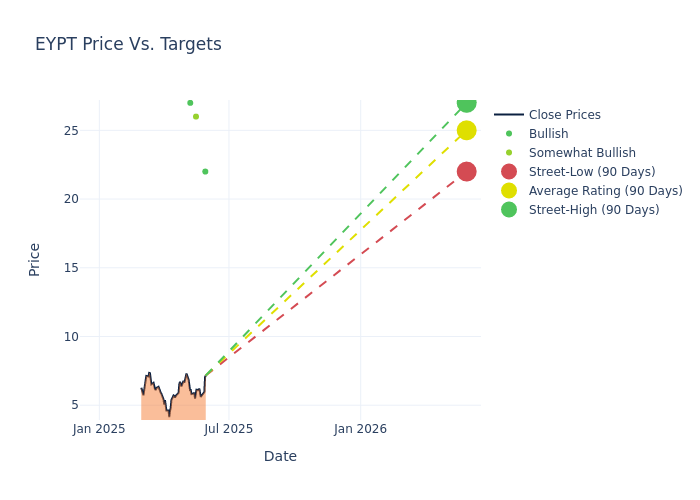Analyst Expectations For EyePoint Pharmaceuticals's Future
EyePoint Pharmaceuticals (NASDAQ:EYPT) underwent analysis by 5 analysts in the last quarter, revealing a spectrum of viewpoints from bullish to bearish.
The table below provides a concise overview of recent ratings by analysts, offering insights into the changing sentiments over the past 30 days and drawing comparisons with the preceding months for a holistic perspective.
| Bullish | Somewhat Bullish | Indifferent | Somewhat Bearish | Bearish | |
|---|---|---|---|---|---|
| Total Ratings | 4 | 1 | 0 | 0 | 0 |
| Last 30D | 1 | 0 | 0 | 0 | 0 |
| 1M Ago | 1 | 1 | 0 | 0 | 0 |
| 2M Ago | 0 | 0 | 0 | 0 | 0 |
| 3M Ago | 2 | 0 | 0 | 0 | 0 |
The 12-month price targets assessed by analysts reveal further insights, featuring an average target of $26.0, a high estimate of $33.00, and a low estimate of $22.00. This current average represents a 7.14% decrease from the previous average price target of $28.00.

Investigating Analyst Ratings: An Elaborate Study
An in-depth analysis of recent analyst actions unveils how financial experts perceive EyePoint Pharmaceuticals. The following summary outlines key analysts, their recent evaluations, and adjustments to ratings and price targets.
| Analyst | Analyst Firm | Action Taken | Rating | Current Price Target | Prior Price Target |
|---|---|---|---|---|---|
| Yi Chen | HC Wainwright & Co. | Maintains | Buy | $22.00 | $22.00 |
| Graig Suvannavejh | Mizuho | Lowers | Outperform | $26.00 | $30.00 |
| Daniil Gataulin | Chardan Capital | Lowers | Buy | $27.00 | $33.00 |
| Daniil Gataulin | Chardan Capital | Maintains | Buy | $33.00 | $33.00 |
| Yi Chen | HC Wainwright & Co. | Maintains | Buy | $22.00 | $22.00 |
Key Insights:
- Action Taken: Analysts frequently update their recommendations based on evolving market conditions and company performance. Whether they 'Maintain', 'Raise' or 'Lower' their stance, it reflects their reaction to recent developments related to EyePoint Pharmaceuticals. This information provides a snapshot of how analysts perceive the current state of the company.
- Rating: Offering a comprehensive view, analysts assess stocks qualitatively, spanning from 'Outperform' to 'Underperform'. These ratings convey expectations for the relative performance of EyePoint Pharmaceuticals compared to the broader market.
- Price Targets: Analysts navigate through adjustments in price targets, providing estimates for EyePoint Pharmaceuticals's future value. Comparing current and prior targets offers insights into analysts' evolving expectations.
Capture valuable insights into EyePoint Pharmaceuticals's market standing by understanding these analyst evaluations alongside pertinent financial indicators. Stay informed and make strategic decisions with our Ratings Table.
Stay up to date on EyePoint Pharmaceuticals analyst ratings.
If you are interested in following small-cap stock news and performance you can start by tracking it here.
About EyePoint Pharmaceuticals
EyePoint Pharmaceuticals Inc is a pharmaceutical company. It is engaged in developing and commercializing ophthalmic products for the treatment of eye diseases. The company has developed FDA-approved sustained-release treatments in ophthalmology. Its pre-clinical development program is focused on using its core Durasert E and Verisome technology platforms to deliver drugs to treat wet age-related macular degeneration, glaucoma, osteoarthritis, and other diseases. Geographically, the firm has operational footprints in the U.S., China, and the UK. It generates a majority of its revenue from the U.S.
EyePoint Pharmaceuticals: A Financial Overview
Market Capitalization Analysis: Falling below industry benchmarks, the company's market capitalization reflects a reduced size compared to peers. This positioning may be influenced by factors such as growth expectations or operational capacity.
Revenue Growth: Over the 3M period, EyePoint Pharmaceuticals showcased positive performance, achieving a revenue growth rate of 109.29% as of 31 March, 2025. This reflects a substantial increase in the company's top-line earnings. As compared to its peers, the revenue growth lags behind its industry peers. The company achieved a growth rate lower than the average among peers in Health Care sector.
Net Margin: EyePoint Pharmaceuticals's net margin excels beyond industry benchmarks, reaching -184.82%. This signifies efficient cost management and strong financial health.
Return on Equity (ROE): EyePoint Pharmaceuticals's ROE lags behind industry averages, suggesting challenges in maximizing returns on equity capital. With an ROE of -14.24%, the company may face hurdles in achieving optimal financial performance.
Return on Assets (ROA): EyePoint Pharmaceuticals's ROA is below industry averages, indicating potential challenges in efficiently utilizing assets. With an ROA of -11.57%, the company may face hurdles in achieving optimal financial returns.
Debt Management: The company maintains a balanced debt approach with a debt-to-equity ratio below industry norms, standing at 0.08.
The Core of Analyst Ratings: What Every Investor Should Know
Benzinga tracks 150 analyst firms and reports on their stock expectations. Analysts typically arrive at their conclusions by predicting how much money a company will make in the future, usually the upcoming five years, and how risky or predictable that company's revenue streams are.
Analysts attend company conference calls and meetings, research company financial statements, and communicate with insiders to publish their ratings on stocks. Analysts typically rate each stock once per quarter or whenever the company has a major update.
Some analysts will also offer forecasts for metrics like growth estimates, earnings, and revenue to provide further guidance on stocks. Investors who use analyst ratings should note that this specialized advice comes from humans and may be subject to error.
Breaking: Wall Street's Next Big Mover
Benzinga's #1 analyst just identified a stock poised for explosive growth. This under-the-radar company could surge 200%+ as major market shifts unfold. Click here for urgent details.
This article was generated by Benzinga's automated content engine and reviewed by an editor.
 Wall Street Journal
Wall Street Journal